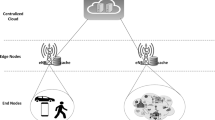Abstract
The 5th generation mobile and wireless communication systems are expected to accommodate exploding traffic, increasing number of devices, and heterogeneous applications driven by proliferation of IoT and M2M technologies. However, the centralized mobility management architecture in a current mobile core network would face critical problems such as excessive concentration of load on specific servers and considerable increase in C-plane overhead. To solve the problems we first consider a novel architecture of distributed mobility management in C-plane in the mobile core network, which employs virtualized mobility management entity called ADMMEs (Autonomous Distributed Mobility Management Entity) in this paper. In addition, to assign an appropriate ADMME to a UE in accordance with mobility characteristics of the UE and a management policy, we propose an autonomous and adaptive ADMME selection scheme. We adopt a biologically-inspired algorithm, called attractor selection, to accomplish adaptive selection taking into account multiple objectives. Through simulation experiments, we confirmed our proposal could accomplish more than 63 % performance improvement comparing to the current method from viewpoints of delay, load balancing, and C-plane overhead under a dynamic mobility scenario.





















Similar content being viewed by others
References
Cisco. (2015). Cisco visual networking index: Global mobile data traffic forecast update, 2014–2019. White Paper.
Chin, W. H., Fan, Z., & Haines, R. (2014). Emerging technologies and research challenges for 5G wireless networks. IEEE Wireless Communications, 21(2), 106–112.
Boccardi, F., Heath, R. W., Lozano, A., Marzetta, T. L., & Popovski, P. (2014). Five disruptive technology directions for 5G. IEEE Communications Magazine, 52(2), 74–80.
Osseiran, A., Boccardi, F., Braun, V., Kusume, K., et al. (2014). Scenarios for the 5G mobile and wireless communications: The vision of the METIS project. IEEE Communications Magazine, 52(5), 26–35.
Park, Y. (2014). 5G vision and requirements of 5G forum, korea. Technical report, February 2014. ITU. URL https://www.itu.int/dms_pub/itu-r/oth/0a/06/R0A0600005F0001PDFE.pdf.
Chan, H., Liu, D., Seite, P., Yokota, H., & Korhonen, J. (2014). RFC 7333: Requirements for distributed mobility management. IETF. https://www.rfc-editor.org/rfc/rfc7333.txt.
Giust, F., De la Oliva, A., & Bernardos, C. J. (2013). Mobility management in next generation mobile networks. In Proceedings of IEEE 14th International Symposium and Workshops on a World of Wireless, Mobile and Multimedia Networks (WoWMoM), pp. 1–3, Madrid, Spain.
An, X., & Pianese, F. (2012). DMME: A distributed LTE mobility management entity. Bell Labs Technical Journal, 17(2), 97–120.
Basta, A., & Kellerer, W. (2014). Applying NFV and SDN to LTE mobile core gateways, the functions placement problem. In Proceedings ofthe 4th workshop on All things cellular: operations, applications, & challenges, pp. 33–38, Chicago, USA.
Kashiwagi, A., Urabe, I., Kaneko, K., & Yomo, T. (2006). Adaptive response of a gene network to environmental changes by fitness-induced attractor selection. PLoS One, 1(1), e49.
Liu, D., Zuniga, J. C., Seite, P., Chan, H., & Bernardos, C. J. (2015). RFC 7429: Distributed mobility management: Current practices and gap analysis. IETF. https://www.rfc-editor.org/info/rfc7429.
Bernardos, C. J., de la Oliva, A., & Giust, F. (2015, March). A PMIPv6-based solution for distributed mobility management. https://www.ietf.org/archive/id/draft-bernardos-dmm-pmip-04.txt.
Lei, J., & Fu, X. M. (2008). Evaluating the benefits of introducing PMIPv6 for localized mobility management. In Proceedings of 2008 International Wireless Communications and Mobile Computing Conference (IWCMC), pp. 74–80, Crete Island, Greece.
Laganier, J., Higuchi, T., & Nishida, K. (2009). Mobility management for all-IP core network. NTT Docomo Technical Journal, 11(3), 34–39.
Lee, J. H., & Pack, S. (2013). Mobility management in future wireless networks: Past, present, and future. IEEE WCNC Tutorial.
Guist, F., Bernarods, C. J., & Oliva, A. (2014). Analytic evaluation and experimental validation of a network-based IPv6 distributed mobility management solution. IEEE Transactions on Mobile Computing, 13(11), 2484–2497.
Costa, R., & Melia, T. (2012). When mobile networks meet content delivery networks: challenges and opportunities. In Proceedings of the seventh ACM international workshop on Mobility in the evolving internet architecture, pp. 11–16, Istanbul, Turkey.
Chan, H. A., Yokota, H., Xie, J., et al. (2011). Distributed and dynamic mobility management in mobile internet: Current approaches and issues. Journal of Communications, 6(1), 4–15.
Lee, J. H., & Yan, Z. W. (2013). Dynamic tunneling for network-based distributed mobility management coexisting with PMIPv6. In Proceedings of IEEE 24th International Symposium on Personal Indoor and Mobile Radio Communications (PIMRC), pp. 2995–3000, London, United Kingdom.
Condeixa, T., & Sargento, S. (2013). Dynamic mobile ip anchoring. In Proceedings of 2013 IEEE International Conference on Communications (ICC), pp. 3607–3612, Budapest, Hungary.
3GPP. (2014). General packet radio service (GPRS) enhancements for evolved universal terrestrial radio access network (E-UTRAN) access. Technical Report TS 23.401 V12.6.0. URL http://www.3gpp.org/DynaReport/23401.htm.
3GPP. (2010). Technical specification group core network and terminals; numbering, addressing and identification. Technical Report TS 23.003 V9.3.0. URL www.qtc.jp/3GPP/Specs/23003-930.pdf.
3GPP. (2011). Technical specification group radio access network; evolved universal terrestrial radio access network (E-UTRAN); architecture description. Technical Report TS 36.401 V10.3.0. URL www.qtc.jp/3GPP/Specs/36401-a30.pdf.
3GPP. (2015). General packet radio service (GPRS) enhancements for evolved universal terrestrial radio access network (E-UTRAN) access. Technical Report TS 23.401 V13.3.0. URL http://www.3gpp.org/DynaReport/23401.htm.
Leibnitz, K., & Murata, M. (2010). Attractor selection and perturbation for robust networks in fluctuating environments. IEEE Network, 24(3), 14–18.
Li, J., Kameda, H., & Li, K. (2000). Optimal dynamic mobility management for PCS networks. IEEE/ACM Transactions on Networking, 8(3), 319–327.
Langar, R., Bouabdallah, N., & Boutaba, R. (2008). A comprehensive analysis of mobility management in MPLS-based wireless access networks. IEEE/ACM Transactions on Networking, 16(4), 918–931.
Jain, R., Chiu, D., & Hawe, W. (1998). A quantitative measure of fairness and discrimination for resource allocation in shared computer systems. ACM Computing Research Repository, cs.NI/9809.
Author information
Authors and Affiliations
Corresponding author
Rights and permissions
About this article
Cite this article
Yang, H., Wakamiya, N., Murata, M. et al. Autonomous and distributed mobility management in mobile core networks. Wireless Netw 23, 2093–2110 (2017). https://doi.org/10.1007/s11276-016-1274-3
Published:
Issue Date:
DOI: https://doi.org/10.1007/s11276-016-1274-3




